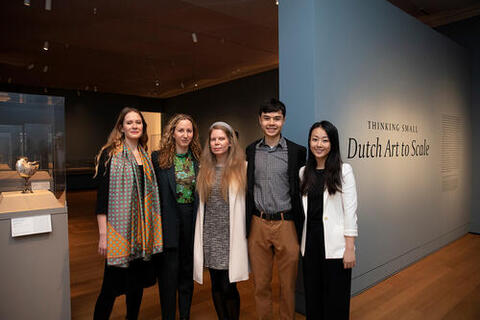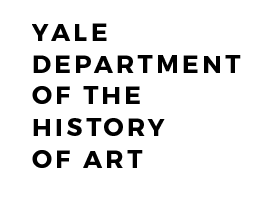Intimate Art: History of Art Students Curate Exhibit at Yale Art Gallery

Intimate Art: History of Art Students Curate Exhibit at Yale Art Gallery
Come close.
No, closer.
Through a wide-ranging selection of fascinating objects from the 17th-century Netherlands, a new exhibit, curated by four students at the History of Art Department, considers the slow, intimate, and contemplative engagement between artwork and observer — and one that reflects the world beyond.
“Thinking Small: Dutch Art to Scale,” runs through July 23 at the Yale University Art Gallery. The exhibit, with a slightly different group of objects, will then be presented at the Museum of Fine Art in Boston in November.
The exhibition features small-scale works in various media drawn from the holdings at the Yale University Art Gallery and other collections across campus, as well as the Center for Netherlandish Art, the Museum of Fine Arts, Boston, and a private collection.
“I thought it was a good project for the pandemic when we were all at home living in small compressed spaces,” says Marisa Bass, Professor in the History of Art who mentored the students for the project. “We were not making big movements in the world during that time so it gave us a chance to consider the virtues of thinking small as opposed to the idea that big is always better. I thought it was the right idea to work with in the moment.”
The project began during the spring of 2021 and group conversations took place over Zoom. Also assisting the students in the project were Jessie Park, the Nina and Lee Griggs Assistant Curator of European Art, Yale University Art Gallery; and Freyda Spira, the Robert L. Solley Curator of Prints and Drawings, Yale University Art Gallery.
“One of the points of the show,” says Bass, “is to say that you can think about what is small, not just in relationships to actual size but to its relative engagements.”
Even large works of art can have that point of view, she says, if it’s a big painting, for example, “that makes you want to be this close to it because it has so many interesting details and hidden elements.”
Or the opposite, she says. “You can look at something very small and yet see a huge context,” says Bass.
For the exhibit, which takes in the period of Dutch global expansion, paintings, medals, books, lockets and other objects filled with minute details lure viewers.
“So what is thinking small?,” asks Adam D. C. B. Chen, (TD ’23, B.A./M.A. candidate, History of Art) and one of the four curators of the exhibit. “Broadly, we define it an action of absorption with a work of art and instances when art objects encourages us to get closer to scrutinize or to get lost in thought through its intricate details or scale.”
In a presentation for the exhibit in late February at the History of Art Department, Chen gave as an example the signature piece of the show — Jan Bellekin’s Nautilus Cup, circa 1660, an engraved shell native to the South Pacific. Its iridescent mother-of-pearl reflects “an irresistible rainbow of colors that is transformed as the light changes… It encourages viewers to spend more time pondering the interpretation of the images while at the same time marveling at their fine skill of the carver.”
Another aspect of the exhibit is how these pieces that have roots from distant parts of the Dutch empire — and which have been appropriated from other cultures — can have a local impact.
“In a society like early modern Netherlands, where space was measured in hours rather than miles or kilometers, spending enough time with a work of art could produce the experience of travel,” says Ekaterina Koposova, Ph.D. student, History of Art. “The second section of Thinking Small highlights how big ideas and large spaces can be captured on small surfaces. The medal on display is the perfect example of this: peace and war are literally two sides of the same coin.”
The emergence of the microscope in that century also created an awareness on the profundity of thinking in minuscule ways, bringing a newfound fascination between the part and the whole.
The study of natural specimens — and especially insects — in the new world of microscopic examination “allowed entry into the world unknown to the naked eye,” says Renata Nagy, Ph.D. candidate, History of Art.
Looking more closely at the three small-sized volumes of insects study by Johannes Goedaert, Nagy points out that an observer can appreciate “a naturalist who has dedicated three decades of his life collecting information and creating these detailed illustrations.” His enthusiasm for exploiting the seemingly insignificant aspects of life, says Nagy, inspires us even today to stop and contemplate the meaning of all things, regardless of their scale.”
Another section of the exhibit titled “Sensing the Small” explores the physical experience of interacting with small things.
“In the seventeenth-century Netherlands, members of the middle and upper classes amassed collections of precious and curious items from near and far,” says Joyce Yusi Zhou, Ph.D. student, History of Art. “Though modern museum visitors cannot handle these works of art, they can begin to envision how doing so would have sparked the imaginations of 17th Century Dutch collectors and viewers. “
The contemplative nature of the show is also reflected in the minimalism of the floor plan and the open space design of the exhibit itself.
“We did not want to compensate for the small-scale pieces with quantity,” says Koposova. “We had faith in them and gave them space to breathe”
The project also introduced the students to the challenges of dealing with practices and limits imposed from museums and collectors with, for example, rare books that had to be encased and light exposures limited.
The exhibit is a relatively rare instance of History of Art Department graduate students curating an exhibit at the Yale University Art Gallery and then one that also traveled to another major museum.
“I think it’s absolutely beautiful and I could not be more proud,” says Bass. “They did a truly beautiful job.”
